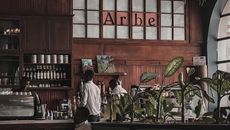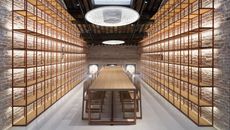Venice turns into ‘laboratory of the future’ with 18th Architecture Biennale opening
Curator Lelsey Lokko’s theme, ‘The Laboratory of the Future’, brings passion, intensity and imagination to the Venice Architecture Biennale 2023, while placing Africa at its heart

When 'The Laboratory of the Future' was announced as the 2023 Venice Architecture Biennale’s main theme, it brought with it enthusiasm and anticipation. No other biennale had tackled creativity and Africa in this way, and many of the participants had never exhibited at the renowned global showcase before. The result, born of curator Lesley Lokko's vision to put the continent of Africa in the spotlight does not disappoint. Opened in the Italian city on 20 May (and running till 26 November, so plan your Venice trip now), the 18th edition of La Biennale di Venezia's architecture exhibition delivers amply on its expectations, offering a mix of imagination, deep research and a sense of discovery, doing exactly what every international festival of its kind should – instigating conversation, widening the profession's horizons, and inviting more ideas, people and territories into its fold.

'Griot' by Studio Barnes
Venice Architecture Biennale 2023: ‘The Laboratory of the Future’
'The Laboratory of the Future' is, as per the biennale's usual arrangement for its main show, spread across two sites – the Arsenale's vast halls and exterior grounds, and the Giardini's generous Central Pavilion. Lokko's curation plays carefully on each location’s strengths, offering site-appropriate displays, as well as a curatorial rhythm that takes the visitor on a journey that blends intensity and respite; looks towards past, present and future; and includes 'traditional' architectural elements (models, drawings, maps) and pieces that appear more abstract, yet are no less powerful or informative.

Sumayya Vally and Moad Musbahi's 'The African Post Office'
The curatorial team smartly calculated a pace that caters to the visitor's need for occasional pause and addresses the biennale exhibition's large scale and nature, while working with 89 contributors this year (a healthy number – for context, the 2018 Yvonne Farrell and Shelley McNamara-curated biennale had 71 entries, and the 2016 one by Alejandro Aravena had 88). True to its bid to offer a platform to under-represented groups and in particular populations related to the continent, over half of the participants are from Africa or the African Diaspora; the overall gender balance is 50/50; and most of the studios taking part are small ones – no big starchitecture or corporate practices here.

Adjaye Associates' 'Kwaeε'
Underscoring that something well begun is half done, the entry and initial sequences to both the Arsenale and Giardini sites feel impactful, engaging and set the scene well for what's to come. The former launches with a captivating video piece by artist and poet Rhael 'LionHeart' Cape greeting visitors, followed by striking drawings and sculpture by Germane Barnes, of Studio Barnes, that examine Western notions of classical antiquity and the idea of a column. Similarly, the Central Pavilion also kicks off with film, this time by David Adjaye – while a room off it, full of large-scale, impressively detailed and immaculately executed architectural models of various new and ongoing projects by the practice, complements the moving image (more models and a life-size pavilion by Adjaye and his team can be found at the Arsenale).

Neri&Hu Design and Research Office's 'Liminality'
Lokko's show comprises six sections, all of which have impressively obtained a sustainability credential, flagging the importance of rethinking the festival model towards a more environmentally friendly future. In Giardini, there's 'Force Majeure', which looks at 16 key practices of African or Diasporic identity – alongside Adjaye, it includes Cote D'Ivoire's Koffi & Diabaté, Berlin-based Burkinabé Kéré Architecture, and South Africa's Sumayya Vally's Counterspace. Most of these are well-known names that have graced the pages of global publications for years and have lots of completed work under their belt. Here, they flex their creative muscle to Lokko's theme – some putting a spotlight on their ongoing work, and some crafting new pieces inspired by the biennale.

Gbolade Design Studio's 'Regenerative Power'
Artist Olalekan Jeyifous' installation, a room set up as the model 'All-Africa Protoport (AAP)', offers a glimpse into a potential future: a travel complex built on and pioneering Indigenous African renewable energy and green technologies. It won the Silver Lion for a promising young participant in the 18th biennale. RCA tutor, architectural designer and researcher Thandi Loewenson's 'The Uhuru Catalogues', a series of large-scale drawings etched into graphite blocks, is also here, examining geopolitical context and powers on Earth alongside ways of seeing the universe. It was awarded a special mention (alongside two more displays, by Twenty Nine Studio and Sammy Baloji, and Wolff Architects respectively).

Thandi Loewenson's 'The Uhuru Catalogues'
At the Arsenale, 'Dangerous Liaisons' looks at works that blur the boundaries between architecture and other disciplines. These span from Flores & Pratts' roomful of models and Neri & Hu's explorations on liminality (a couple of the more conventional biennale rooms, where building projects take centre stage), to Gbolade Design Studio's deep dive into the game of dominoes and its role in the South London Windrush generation communities.
Wallpaper* Newsletter
Receive our daily digest of inspiration, escapism and design stories from around the world direct to your inbox.

DAAR – Alessandro Petti and Sandi Hila's 'Ente di Decolonizzazione – Borgo Rizza'
Meanwhile, the 'Curator’s Special Projects' span topics including sustainability, gender and memory, as well as emerging practitioners. 'Guests from the Future' represents younger practitioners breaking into the scene with strong theses and captivating visuals. The work is rich and extremely varied, from London-based community Black Females in Architecture, to the mesmerising tapestries of architecture student Arinjoy Sen (created in collaboration with Indian craftspeople), Juergen Strohmayer and Glenn DeRoché's Surf Ghana Collective building, and the sculptures of artist Ibiye Camp. It underlines once more Lokko's intent on flagging new points of view and offering a platform to those who often don't have one at the biennale.

Arinjoy Sen's 'Bengali Song'
While the opening celebrations are now behind us, there is more to come, keeping up the pace and interest around the 2023 Venice Architecture Biennale's themes. Launching for the first time, the Biennale College Architettura will run from 25 June to 22 July 2023, and throughout its duration, 15 renowned international tutors – such as Marina Otero, Nana Biamah-Ofosu, Sarah de Villiers and Manijeh Verghese – will work with 50 students, early-career practitioners and academics from around the world during a four-week teaching programme.

Ibiye Camp's ‘Rebellious Copies’
Meanwhile, a new Venice Architecture Biennale feature titled 'Carnival', including lectures, discussions, film and performances, will accompany the displays, seen by the curatorial team as crucial in drawing in the public and enhancing the dialogue between architecture and the world.

Black Females in Architecture
Lokko described the biennale as 'an agent of change', saying that in architecture, the dominant voice has historically been from one perspective only, and ‘the “story” of architecture is therefore incomplete. Not wrong, but incomplete. It is in this context particularly that exhibitions matter.’
Through its uncovering of fresh perspective, challenge to existing systems and acceptance of multiple viewpoints, 'The Laboratory of the Future' is here to herald a much-needed shift in the architecture realm. It is a show that will no doubt be remembered for its talent and energy, as well as its thought-provoking content, a biennale that spearheads optimism and, hopefully, evolution.

Dream The Combine's 'afterimages'

Koffi & Diabaté Architectes' 'Living Differently: Architecture, Scale and the New Core'

Studio Sean Canty's 'Edgar’s Sheds'

Kéré Architecture's 'Counteract'

atelier masōmī's 'Process'

Rhael ‘LionHeart’ Cape's 'Those With Walls for Windows'
Ellie Stathaki is the Architecture & Environment Director at Wallpaper*. She trained as an architect at the Aristotle University of Thessaloniki in Greece and studied architectural history at the Bartlett in London. Now an established journalist, she has been a member of the Wallpaper* team since 2006, visiting buildings across the globe and interviewing leading architects such as Tadao Ando and Rem Koolhaas. Ellie has also taken part in judging panels, moderated events, curated shows and contributed in books, such as The Contemporary House (Thames & Hudson, 2018), Glenn Sestig Architecture Diary (2020) and House London (2022).
-
 RIBA House of the Year 2024: browse the shortlist and pick your favourite
RIBA House of the Year 2024: browse the shortlist and pick your favouriteThe RIBA House of the Year 2024 shortlist is out, celebrating homes across the UK: it's time to place your bets. Which will win the top gong?
By Ellie Stathaki Published
-
 The Nothing Phone (2a) Plus Community Edition taps into the brand's creative followers
The Nothing Phone (2a) Plus Community Edition taps into the brand's creative followersThe unconventional features of Nothing Phone (2a)’s new limited edition come from a community-driven project to reshape the style and ethos of the smartphone
By Jonathan Bell Published
-
 What is the sound of Stone Island? A new musical project helps you find out
What is the sound of Stone Island? A new musical project helps you find outStone Island Sound is a new, evolving music project from the Italian label, seeing contributions from John Glacier, Yaeji and more across playlists and live performances
By Jack Moss Published
-
 Venice Architecture Biennale 2025: a glimpse of what’s to come and Carlo Ratti's circular economy manifesto
Venice Architecture Biennale 2025: a glimpse of what’s to come and Carlo Ratti's circular economy manifestoVenice Architecture Biennale 2025 curator Carlo Ratti talks about the theme, 'Intelligens' and launches his circular economy manifesto; the first glimpses into what’s to come at the festival's launch next spring
By Ellie Stathaki Last updated
-
 Year in review: top 10 architecture stories of 2023, selected by Wallpaper* architecture editor Ellie Stathaki
Year in review: top 10 architecture stories of 2023, selected by Wallpaper* architecture editor Ellie StathakiStathaki presents her top 10 architecture stories of 2023, from a world-leading festival to lesser-known 20th-century architecture, contemporary transport hubs, museums and a pool to splash in
By Ellie Stathaki Published
-
 Carlo Ratti announced curator of Venice Architecture Biennale 2025
Carlo Ratti announced curator of Venice Architecture Biennale 2025Carlo Ratti has been revealed as the Director of the Architecture Department at the Venice Architecture Biennale 2025, with the specific task of curating the 19th International Architecture Exhibition
By Ellie Stathaki Published
-
 Year in review: the top 10 house stories of 2023, as selected by Wallpaper’s Ellie Stathaki
Year in review: the top 10 house stories of 2023, as selected by Wallpaper’s Ellie StathakiDiscover our top 10 house stories of 2023, from modernist reinventions to urban dwellings and idyllic retreats
By Ellie Stathaki Published
-
 Nexus House caters to the Los Angeles lifestyle near Venice Beach
Nexus House caters to the Los Angeles lifestyle near Venice BeachNexus House by Woods + Dangaran is a Venice house perfect for the Los Angeles lifestyle
By Ellie Stathaki Published
-
 Lenny Steinberg invites us to her Los Angeles home: watch the film
Lenny Steinberg invites us to her Los Angeles home: watch the filmInside the Venice Beach home of designer Lenny Steinberg, who takes inspiration from movement and music, and guides us through her treasures
By Mimi Zeiger Published
-
 A Somali café by Omar Degan supports community in Mogadishu
A Somali café by Omar Degan supports community in MogadishuArbe, a Somali café by Omar Degan, offers a gathering hub for the community in Mogadishu
By Ellie Stathaki Published
-
 Interactive exhibition at Procuratie Vecchie in Venice encourages coexistence and collaboration
Interactive exhibition at Procuratie Vecchie in Venice encourages coexistence and collaborationGenerali Group opens interactive exhibition ‘A World of Potential’ in the restored Procuratie Vecchie in Venice
By Ifeoluwa Adedeji Published